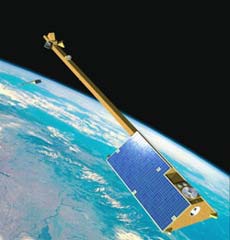A "Swarm" of satellites for a unique look inside the Earth

Swarm is an Earth Explorer Opportunity Mission candidate. The Swarm constellation will study the dynamics of the Earth’s magnetic field and its interactions with the Earth system. <br>Credit: ESA <br>
ESA PR 30-2004. ESA’s Earth Observation Programme Board has just decided which of the six Earth Explorer candidate missions, presented earlier in April at the User Consultation Meeting, will be developed and launched. Swarm, an Earth Explorer Opportunity Mission, is a constellation of satellites which will study the Earth’s magnetic field.
A further selection between the Earth Explorer Core Missions EarthCARE (Earth Clouds Aerosols and Radiation Explorer) and SPECTRA (Surface Processes and Ecosystem Changes Through Response Analysis) has been deferred to November 2004 allowing clarifications to be made for both missions. It was recommended that the EGPM (European contribution to Global Precipitation Measurement) mission should be furthered within the ESA Earth Watch framework.
Based upon the recommendations made by the Earth Science Advisory Committee and the ESA Director of Earth Observation, the choice of Swarm for full implementation was unanimously agreed upon as a result of its scientific excellence. ESA has successfully moved to the next round of missions that explore our environment and the Earth as a system. Together with the decision expected in November for an additional Core Explorer, ESA is at a point where the next generation of scientific missions can be initiated. In this context the Agency is planning a Call for Mission Proposals in September 2004.
The objective of the Swarm mission is to provide the best ever survey of the geomagnetic field and its temporal evolution, in order to gain new insights into the Earth system by improving our understanding of the Earth’s interior and climate. The mission is scheduled for launch in 2009. After release from a single launcher, a side-by-side flying lower pair of satellites at an initial altitude of 450 km and a single higher satellite at 530 km will form the Swarm constellation.
High-precision and high-resolution measurements of the strength, direction and variation of the magnetic field, complemented by precise navigation, accelerometer and electric field measurements, will provide the necessary observations that are required to separate and model various sources of the geomagnetic field. This results in a unique “view” inside the Earth from space to study the composition and processes in the interior. It also allows the analysis of the Sun’s influence within the Earth system. In addition, practical applications in many different areas, such as space weather, radiation hazards, navigation and resource exploration, benefit from the Swarm concept.
For further information, please contact :
ESA Media Relations Division
Tel: +33(0)1.53.69.7155
Fax: +33(0)1.53.69.7690
Roger Haagmans
Principle Scientist Solid Earth
Science and Applications Department
Earth Observation Programmes Directorate
Tel: +31 71 565 3506
Fax : +31 71 565 5675
e-mail roger.haagmans@esa.int
Media Contact
More Information:
http://www.esa.int/export/esaLP/SEMXZH2VQUD_index_0.htmlAll latest news from the category: Earth Sciences
Earth Sciences (also referred to as Geosciences), which deals with basic issues surrounding our planet, plays a vital role in the area of energy and raw materials supply.
Earth Sciences comprises subjects such as geology, geography, geological informatics, paleontology, mineralogy, petrography, crystallography, geophysics, geodesy, glaciology, cartography, photogrammetry, meteorology and seismology, early-warning systems, earthquake research and polar research.
Newest articles

Parallel Paths: Understanding Malaria Resistance in Chimpanzees and Humans
The closest relatives of humans adapt genetically to habitats and infections Survival of the Fittest: Genetic Adaptations Uncovered in Chimpanzees Görlitz, 10.01.2025. Chimpanzees have genetic adaptations that help them survive…

You are What You Eat—Stanford Study Links Fiber to Anti-Cancer Gene Modulation
The Fiber Gap: A Growing Concern in American Diets Fiber is well known to be an important part of a healthy diet, yet less than 10% of Americans eat the minimum recommended…

Trust Your Gut—RNA-Protein Discovery for Better Immunity
HIRI researchers uncover control mechanisms of polysaccharide utilization in Bacteroides thetaiotaomicron. Researchers at the Helmholtz Institute for RNA-based Infection Research (HIRI) and the Julius-Maximilians-Universität (JMU) in Würzburg have identified a…



